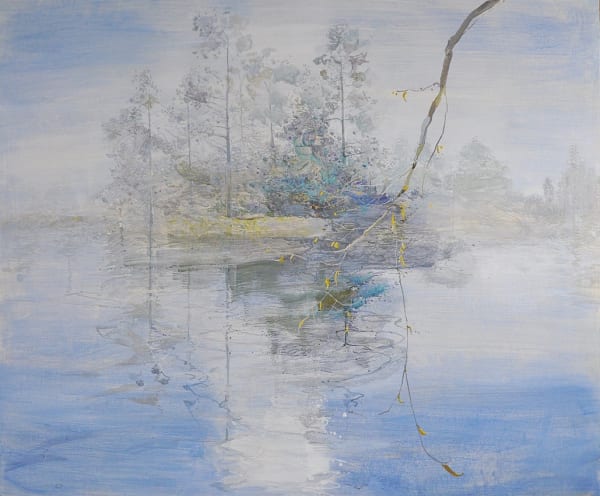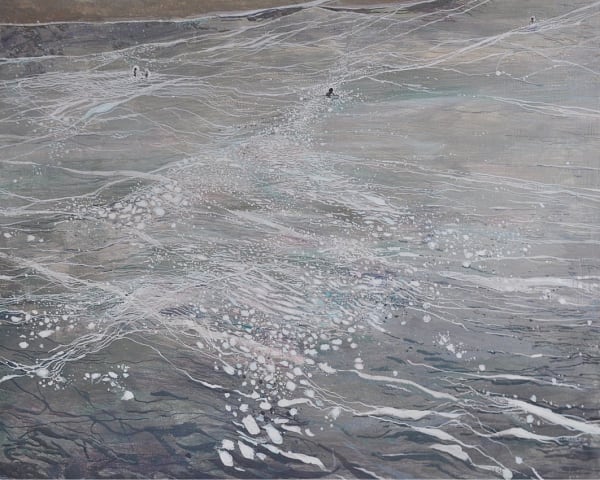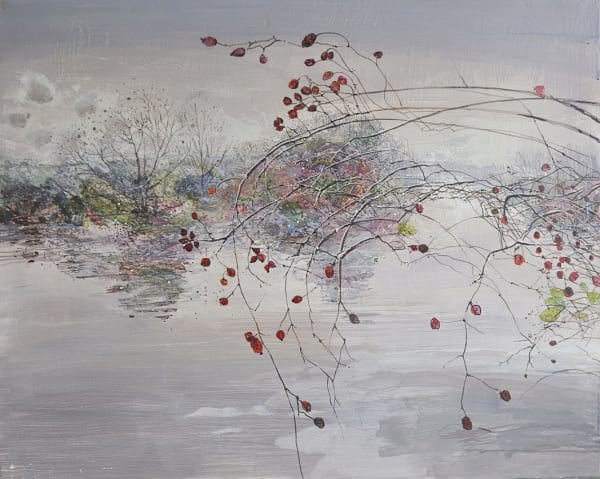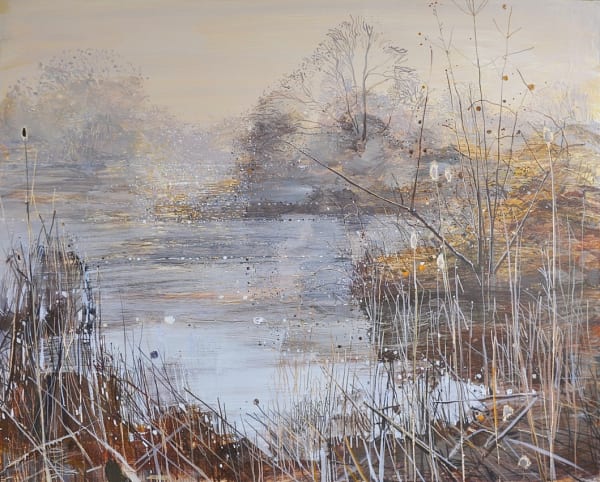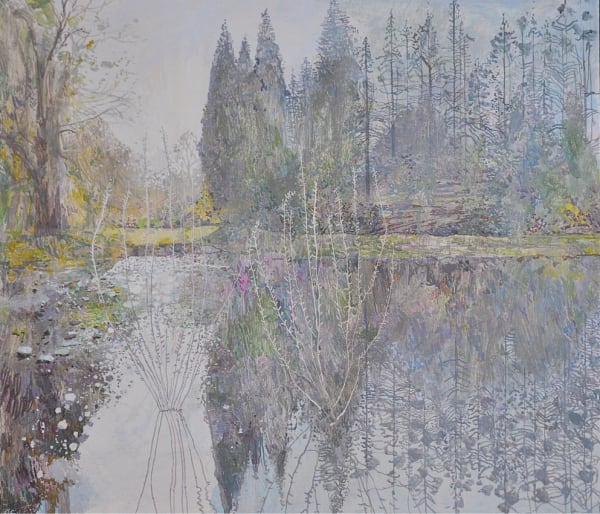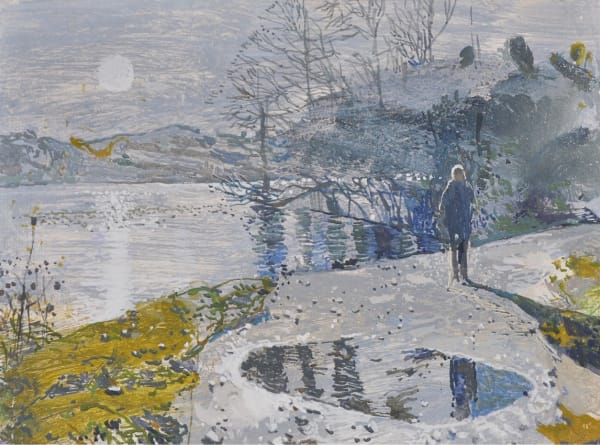This month, we're happy to shine the spotlight on egg tempera painter Ruth Stage whose exhibition 'Happenings' opens at the Russell Gallery on 12 March 2020. She tells us about the inspiration behind her compositions, how she achieves drama and luminosity in her work, her fascination with changing colours, and how she uses figures and landscape give her work narrative. She starts by telling us about her current body of work . . .
"At the moment, I am further developing the interests that have been born from earlier paintings: water, from infinite seas to small incidental puddles ... vegetation, from the study of a magnolia bud. to lines of trees planted by horticulturists. to distant forests ... beaches, paths, riverbanks and the things that we seek out in our leisure activities.

‘Reflected Grasses'
I look out for unusual rhythm and pattern in these landscapes. Compositions enhanced by the time of day, the weather, or the presence of people and - in particular - the way the light falls on a scene, all play a part in the selection of images. It’s been enjoyable to roam around parks, riverbanks and beaches, but this is only the start of the process.
Once back in the studio, I study my drawings and photographic records. The paintings are in egg tempera on handmade gesso boards. The boards require laborious preparation, so I make them in large batches. If I start lots of paintings, there is plenty of room for mistakes! The gesso is made from glue size and chalk whiting. Several layers are painted on warm and then sanded and then sealed with a final layer of size. I feel the story of each painting starts with the gesso as its texture and absorbency are key.
I have developed my egg tempera technique to achieve maximum drama and luminosity, whilst at the same time retaining a strong figurative element. I often start with a wash applied with a wide brush. There will be many subtly different colours within this wash. The colour, however, is often a strong, vibrant hue and as a base will influence the subsequent layers of brushwork. I will often scratch back to reveal this hue, as in ‘Translucent Evening Light’.

‘Translucent Evening Light'
Often the first stage of a Stage is quite experimental. I will then rein in the image using the type of fine-pointed brushes that are more traditionally used with egg tempera. Carefully drawn rhythmical lines in tertiary hues delineate branches, stems, ripples and waves.
I have found the low position of a setting or rising sun can animate and dramatise a scene. Vivid colour drains from the scene and becomes less literal in low light. I find that there are many more options for experimentation when depicting scenes at this time of day. For example, in the central darker area of ‘Gardens’ the colour alternates between violets, emeralds and turquoise, and is punctuated by a strong cadmium yellow. These colours of the shadows are imagined as if there is a strong light coming from behind the tree line.

‘Gardens'
I am also fascinated by the differing colour of an object as affected by what is around it. A reed can be a pale straw colour when compared to dark ground cover, and then become a vibrant violet silhouette against a lake which is radiating reflected light. I’m sure that optical science can explain this phenomenon but it always seems totally absorbing and fantastical.
A figure will always command attention and give a sense of scale. Their clothing usually tells us something about the time of year and current weather conditions and give a sense of what is going on. Often narrative comes from the landscape itself. In ‘Gardens’ it’s a branch falling across the foreground bursting into life. In ‘River Thicket’, it’s the great tangle of undergrowth, contrasted by a calm blue sky and band of water.

‘River Thicket'
However, in ‘Shallows’ and ‘Beach Stroll with Dalmatian’ it’s all about the figures (and partly a camouflaged dog, of course). Their clothing sets the temperature of the painting as does their stance – bathing in sunshine or cowering against an icy wind.

‘Shallows' and 'Beach Stroll with Dalmatian'
In ‘Figure in Moonlight’, the figure balances the moon by being placed on the opposite side of the composition, almost disappearing into the undergrowth behind. She is delineated by a halo, adding mystery, which I like to leave a hint of in all my work.

‘Figure in Moonlight'
Looking ahead, I would love to explore the amazing beaches of both the west coast of Ireland and Scotland. I am constantly inspired by coastline, especially from high vantage points. And as I have made a lot of paintings about Kew Gardens, I would like to explore more ‘designed’ gardens, such as Fountains Abbey in North Yorkshire, and the tropical valley gardens of Cornwall such as the Lost Gardens of Heligan.
I’m intrigued by the representation of great distance – how a brightly coloured tree can be effectively represented in the distance by a small spot of grey paint. In the past, I have loved the drama of Yosemite Valley in California and the Maasai Mara Reserve in Kenya, and I’m sure there are other places in Africa or the USA which would offer exciting vantage points, coupled with a strong vivid light. I have been lucky enough to explore Iceland, where the landscape had an amazing otherworldliness, and have a feeling that the Canary Islands may inspire in a similar way. Having said this, in all honesty, many of my paintings happen from chance unexpected encounters around London and by visiting my native North East. So I always have to be prepared!"
You can also find out more about Ruth and her work on her artist profile page which features more examples of her paintings, some of which are available to purchase online.
